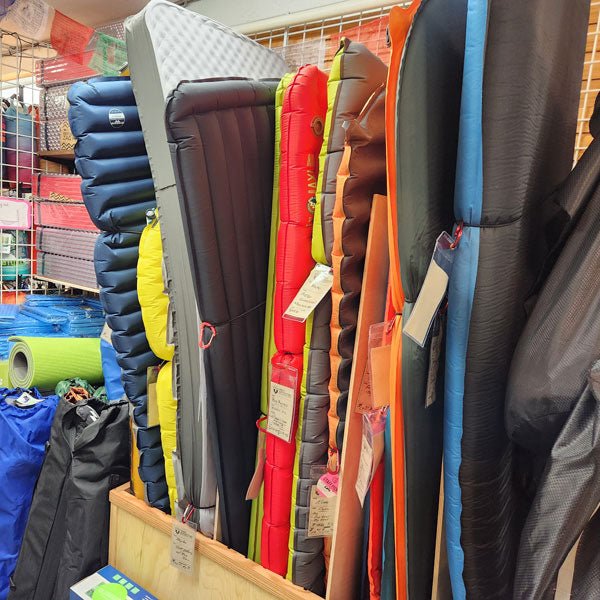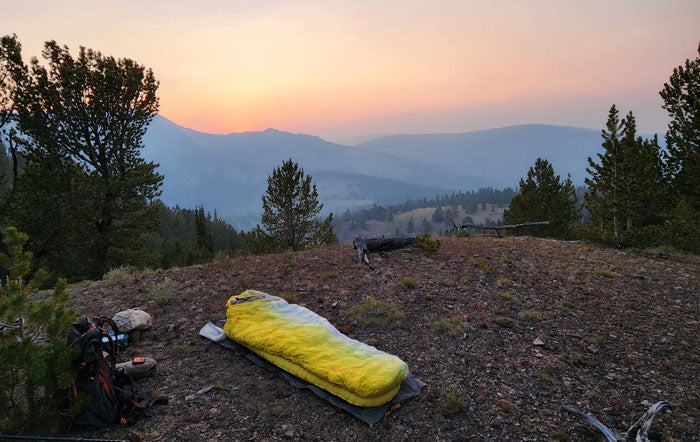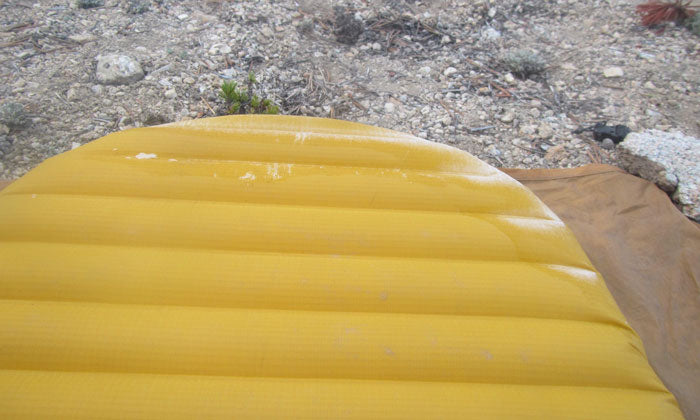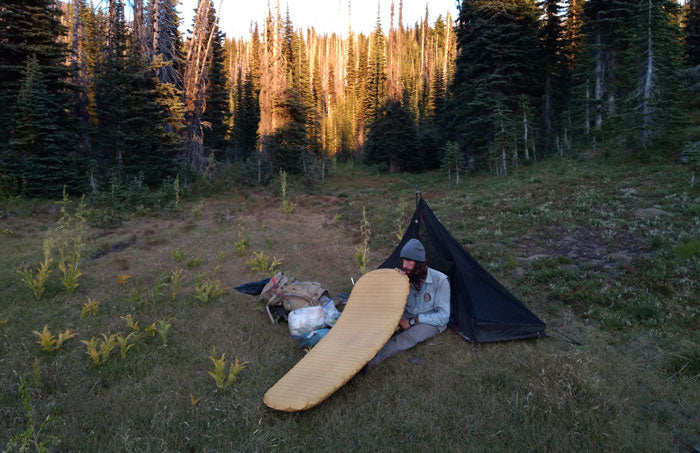
Buying Guide: Sleeping Pads
Looking for a new sleeping pad? Overwhelmed by the wide array of choices available? You’ve come to the right place! Sleeping pads are one of the most overlooked pieces of gear in a camping setup; choosing the right sleeping pad can be just as important as selecting a sleeping bag and choosing the wrong one can ruin a camping trip and result in a sleepless night in the backcountry.
It’s important to remember, there’s more to sleeping pads than just what you find most comfortable. You should also consider the insulation, or R-value rating of your sleeping pad, and the material the pad is made of. In this blog post I’ll explain what R-value is and why it is maybe the most important feature of any sleeping pad, and we’ll talk about the three types of sleeping pads and the customers who might find each of these most useful. We’ll then discuss a few additional features to consider when buying a sleeping pad. I’ll finish by sharing a few of my staff picks as places to start when shopping.
Because the world of sleeping pads includes everything from queen-sized inflatable mattresses all the way down to half-inch-thick foam sheets, before you begin shopping there are a few questions you should ask yourself:
- Where do I plan to use this sleeping pad? (Will it be carried on backpacking trips, or used at drive-in campsites or as a spare mattress when guests visit?)
- When do I plan to use this sleeping pad? (What's the coldest weather you might go camping in? Are you a fair-weather camper, or will you ever be sleeping on snow?)
The answers to these questions will help you know what R-value to look for when shopping for a sleeping pad and help to choose between the three types of sleeping pads. We'll return to these questions later in this blog post.

R-value
Why is R-value important? When you’re lying inside your sleeping bag at night, you’re compressing the insulative material below you- which means that no matter how warm your sleeping bag is, it is doing nothing to protect you from the cold ground below. That’s where your sleeping pad comes in. Sleeping pads are designed with various techniques to prevent cold from seeping through from the ground.
R-value is to a sleeping pad what a temperature rating is to a sleeping bag. R-value is a measure resistance to heat transfer between the top and bottom of a sleeping pad (between the sleeper and the ground). The higher the R-value, the less heat transfer the pad will allow and the warmer the pad’s “temperature rating” will be. Knowing the coldest weather you might be camping in will determine the R-value you should look for in a new pad.
So how do you decode R-values? R-values range from about 1 to 7, and for the average user, the numerical R-value should match the number of seasons during which you plan to use the pad. For example, if you only plan to camp in the summer, an R-value of 1 will be sufficient; if you plan to camp during 3 seasons (spring through fall), you’ll want an R-value of 3 or higher; and if you want a pad that will work year-round (or if you predict you might be camping when temperatures are below freezing), you’ll want an R-value of at least 4. An R-value higher than this might leave you sweating during hot summer nights, but if you plan to go camping on snow, the higher the R-value the better.
One last thing to keep in mind: R-values are accumulative. This means that if you stack two sleeping pads on top of each other, The total R-value will be the sum of the two individual pads. If you already own a three-season pad and want to try winter camping, buying a thin foam pad and stacking the two together will allow you sleep comfortably in colder temperatures.
 This sleeping pad has an R-value of 4- and so, it is warm enough for use on frosty nights.
This sleeping pad has an R-value of 4- and so, it is warm enough for use on frosty nights.
Types of Sleeping Pads
Choosing a range of R-values will help narrow your search for a sleeping pad, but then you will have to choose what type of pad you are looking for. This is where the intended use comes in. There are three general types of pads: Air Pads, open-cell foam pads (or Self-inflating Pads) and Closed-Cell Foam Pads.
Air Pads: Air pads are sleeping pads that are entirely filled with air. Because they are basically giant balloons, they are incredibly lightweight and compact, and are therefore a favorite amongst ultralight backpackers. Many people also consider these to be the most comfortable pads, as they can be very thick and allow the user to adjust air pressure inside the pad for maximum comfort. However, air pads by default have a lower R-value (air is not a good insulator), and while high R-value air pads exist, adding insulation to the pad makes them more expensive. Air pads also tend to be more fragile (though repairs are usually not difficult), so air pads are sometimes not ideal for heavy use or for people camping with dogs. And they require a little more work to inflate at the end of the day.
Self-Inflating Pads: These pads are an air-foam hybrid; they pack up pretty small for easy transport, but because they are filled with foam they inflate to full size on their own when removed from their packaging. Self-inflating pads usually have a higher R-value because the foam layer is insulative; they are also more durable and affordable than air pads. They are firmer than air pads so especially when thick can be very comfortable. However, they tend to be bulkier and more cumbersome than air pads and can still be punctured so it is important to know how to care for and patch them.
Closed Cell Foam Pads: Closed Cell Foam Pads are just sheets of foam; they do not compress, though they usually fold or roll up. They are lightweight, inexpensive, and have great insulation so are often used for layering with other pads during winter camping. Because they are so light, they are also used for backpacking, though they are bulky and usually need to be attached to the outside of a backpack. They are the least comfortable of the sleeping pad options.
 Three examples: an air pad, a self-inflating pad, and a closed cell foam pad
Three examples: an air pad, a self-inflating pad, and a closed cell foam pad
Additional Features
There are a few other features to consider when purchasing a sleeping pad. Sleeping pad size is a huge part of getting a good night’s sleep. Be sure to check the thickness of the pad for an idea of how comfortable it might be, as well as the width and length. Many pads come in different sizes; at 6’3’’, I need to use a “long” sleeping pad or my feet will hang off the end. If you are an active sleeper, consider purchasing a wider pad so you don’t roll off during the night. If you are a side sleeper, a thicker pad will keep your shoulders and hips off the ground. Baffle Design is an often-overlooked feature. Baffle design refers to the texture of the pad; some pads have horizontal baffles while others have vertical, and different people find different textures more comfortable.
Finally, consider the size and weight of the packed sleeping pad. If your pad is intended for backpacking, is it light enough to carry in your pack? If it is intended for travel or car camping, will it fit with the rest of your camping gear?

Conclusion
There are many factors and variables to consider when choosing a sleeping pad, but by thinking about the intended use of the pad and looking for a pad with the proper R-value and construction, you should be able to narrow down your choices. If you can, it is always a good idea to lay on a sleeping pad and test it out before purchasing it. The staff at Next Adventure will be happy to help you do this! Head into your local shop to see our many new and used sleeping pad options or to speak with a staff member and check out the staff picks below for some suggestions.
Staff Picks
- Kelty Cosmic- A great price for a self-inflating, 4-season sleeping pad.
- Thermarest NeoAir Xtherm Max- A lightweight air pad with a very high R-value, perfect for your winter camping and backpacking trips.
- Thermarest NeoAir Xlite Sleeping Pad- A durable, lightweight, and compact air pad perfect for 3+ season backpacking.
- Wilderness Technology Reflective Zag Pad- A great deal on a lightweight closed cell foam pad, perfect for layering for warmth or for lightweight camping,
- Wilderness Technology Comfort Pillowtop- Maybe the most comfortable sleeping pad we carry; ideal for travel and drive-in camping.
- Wilderness Technology Airlight II- An inexpensive lightweight air pad, perfect for summer backpacking trips.


